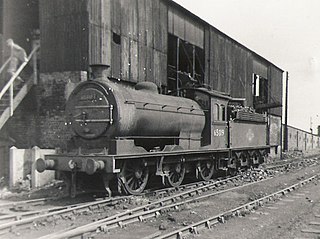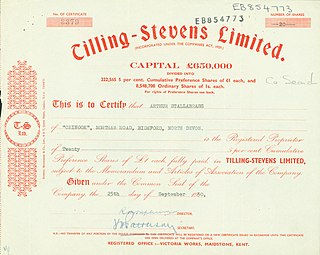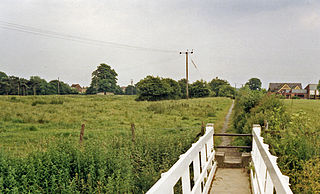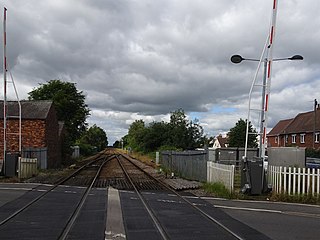
A railcar is a self-propelled railway vehicle designed to transport passengers. The term "railcar" is usually used in reference to a train consisting of a single coach, with a driver's cab at one or both ends. Some railway companies, such as the Great Western, termed such vehicles "railmotors".

The North Tyneside Steam Railway and Stephenson Steam Railway are visitor attractions in North Shields, North East England. The museum and railway workshops share a building on Middle Engine Lane adjacent to the Silverlink Retail Park. The railway is a standard gauge line, running south for 2 miles (3.2 km) from the museum to Percy Main. The railway is operated by the North Tyneside Steam Railway Association (NTSRA). The museum is managed by Tyne and Wear Archives and Museums on behalf of North Tyneside Council.

Sentinel Waggon Works Ltd was a British company based in Shrewsbury, Shropshire that made steam-powered lorries, railway locomotives, and later, diesel engined lorries, buses and locomotives.

The North Eastern Railway (NER) Class P3, classified J27 by the LNER, is a class of 0-6-0 steam locomotive. The P3 Class was designed by Wilson Worsdell and was a relatively minor modification of the existing North Eastern Railway Class P2. The most significant change was a deeper firebox with shallower sloping fire grate. This was achieved by raising the boiler slightly, and by reducing the clearance between the firebox and the rear axle. The P3 Class were a freight engine by nature and used for hauling long trains of freight.

The LNER electric units were electric multiple units that ran on the Tyneside Electrics, a suburban system around the English city of Newcastle upon Tyne. In 1937 the London and North Eastern Railway (LNER) received articulated twin passenger electric units to replace the NER electric units that had been built in 1904–15 by the North Eastern Railway. The order including some single-unit motor parcel vans and motor luggage vans. In the 1960s declining passenger numbers and the high cost of renewing life-expired electric substation equipment across the system led to the replacement of the electric multiple units with diesel multiple units and the units were all withdrawn in 1967.

Tilling-Stevens was a British manufacturer of buses and other commercial vehicles, based in Maidstone, Kent. Originally established in 1897, it became a specialist in petrol-electric vehicles. It continued as an independent manufacturer until 1950, when it was acquired by the Rootes Group.
Railmotor is a term used in the United Kingdom and elsewhere for a railway lightweight railcar, usually consisting of a railway carriage with a steam traction unit, or a diesel or petrol engine, integrated into it.

The North Eastern Railway (NER) Bogie Tank Passenger (BTP) locomotives were designed by Edward Fletcher in 1873. The locomotives were for hauling passenger services on branch lines. They had an 0-4-4 wheel layout and a total of 124 locomotives were built. They were designated G6 by the London and North Eastern Railway (LNER).

The Maudslay Motor Company was a British vehicle maker based in Coventry. It was founded in 1901 and continued until 1948 when it was taken over by the Associated Equipment Company (AEC) and along with Crossley Motors the new group was renamed Associated Commercial Vehicles (ACV) Ltd.
The NZR RM class Westinghouse railcar was an experimental railcar built by the New Zealand Railways Department (NZR) in 1914. Although not the first railcar to operate in New Zealand, it was the first to enter revenue service.
The London and North Eastern Railway (LNER) inherited several styles of coaching stock from its constituents. Sir Nigel Gresley continued the styles that he had established pre-grouping at the Great Northern Railway (GNR) and for the East Coast Joint Stock.
The London and North Eastern Railway used a few petrol and diesel locomotives. These included the LNER Class Y11 petrol locomotives, the diesel shunters which later became British Rail Class D3/9 and British Rail Class D3/14 and the Kitson-Still steam diesel hybrid locomotive. During the 1930s, Armstrong Whitworth supplied an experimental 1-Co-1 diesel-electric locomotive and several diesel-electric railcars. In the 1940s, the LNER had twenty-five 1,600 hp main-line diesel locomotives on order. These would have been similar to the British Rail Class D16/1 and British Rail Class D16/2 but the order was cancelled after nationalisation in 1948.

Hurst, Nelson and Company Ltd was a railway rolling stock manufacturer based in Motherwell, Scotland. The company also built many railway wagons, as well as trams and trolleybus carosseries for several local authorities.

The Cawood, Wistow and Selby Light Railway (CW&SLR) was a short light railway in a rural part of Yorkshire, England. The company was sometimes referred to as the Cawood, Wistow and Selby Railway.

Diesel multiple units and railcars are trains, usually with passenger accommodation, that do not require a locomotive. Railcars can be single cars, while in multiple units cars are marshalled together with a driving position either end. As of December 2010, 23 percent of the rail passenger cars used on Network Rail are part of a diesel multiple unit.

A steam railcar is a rail vehicle that does not require a locomotive as it contains its own steam engine. The first steam railcar was an experimental unit designed and built in 1847 by James Samuel and William Bridges Adams. In 1848, they made the Fairfield steam carriage that they sold to the Bristol and Exeter Railway, who used it for two years on a branch line.
Petrol–electric transmission or gasoline–electric transmission or gas–electric transmission is a transmission system for vehicles powered by petrol engines. Petrol–electric transmission was used for a variety of applications in road, rail, and marine transport, in the early 20th century. After World War I, it was largely superseded by diesel-electric transmission, a similar transmission system used for diesel engines; but petrol-electric has become popular again in modern hybrid electric vehicles.

Hartlepool railway station was a railway station that served the Headland area of Hartlepool in the ceremonial county of Durham, North East England. Though originally built as the coastal terminus of the Hartlepool Dock & Railway in 1839, for most of its life the station was the terminus of a shuttle service from the town's main station in West Hartlepool.
Wistow was the sole intermediate station of the short Cawood, Wistow and Selby Light Railway (CW&SLR), in rural North Yorkshire, England. The line was connected to the North Eastern Railway (NER) at its southern end.

Selby (Brayton Gates) was the initial, temporary southern terminus of the short Cawood, Wistow and Selby Light Railway (CW&SLR) in North Yorkshire, England. The line was connected to the North Eastern Railway (NER) nearby. The station is sometimes referred to as "Brayton Gates" or plain "Selby", though it was around a mile from the much larger Selby station.
















